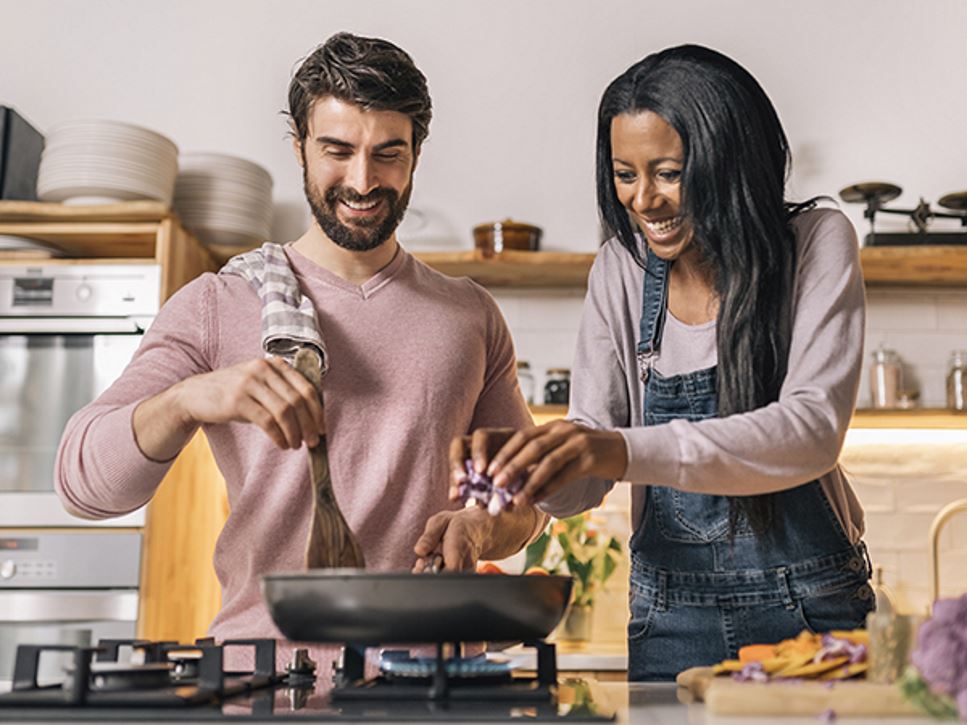Cooking can be good for you and the planet. People who eat more home-cooked meals not only tend to consume more fruits, vegetables and dietary fiber, but also eat less saturated fat and salt. Homemade food also can be budget-friendly and reduces use of takeout containers.
But where do you start? Here are eight tips to develop basic cooking skills, especially if you have a small kitchen, limited utensils and appliances or a tight budget.
Get a cookbook.
While there are excellent recipes online, food-covered fingers and electronic devices don’t mix. Cookbooks often have photos of the cooking process and finished product, plus they don’t require tapping or scrolling to keep a screen from going dark. Always read through a recipe several times and consider writing notes in the margins of books you own. For example, note if ingredients must be chopped before beginning. A cookbook written by a registered dietitian nutritionist often contains healthful and delicious recipes with easy preparation techniques.
Plan to reduce wasted food.
Cooking involves prepping ingredients such as produce. Skip the somewhat daunting step of chopping by buying frozen or canned vegetables and fruits. Frozen, canned and dried foods may help reduce waste because they have a longer shelf life. Plus, the steel cans used for canned foods are 100% recyclable. If you choose to use fresh produce, save the scraps for a flavorful stock or soup recipe.
Boil dried beans and grains.
You can make any number of grain or bean-based meals for a relatively low cost. Bring your own containers to the supermarket and shop the bulk bins to avoid extra packaging. Try cooking these grains: oats, farro, millet, teff, barley, quinoa, buckwheat, bulgur or wheat berries. There are best practices for cooking different bean varieties and whole grains, but consider trying this easy method (note: especially for beans or grains that require longer cooking times, frequently check the water level to ensure the pot doesn’t cook dry and burn):
- To a pot, add 1 cup of lentils, whole grains or soaked, drained and rinsed dried beans.
- Cover with 2 to 3 cups water and ¼ teaspoon salt.
- Bring to a boil, cover, then reduce heat to simmer.
- Cook lentils 20 to 40 minutes (unless split, which cook in only 5 to 10 minutes); cook brown rice 40 to 45 minutes; or cook beans 1 to 2 hours, or until tender.
Perfect pasta.
It’s easy to overcook and waterlog pasta if you wait for the water to come to a boil before setting the timer. Refer to the directions on the package and follow these steps:
- Bring a pot of water to boil (10 to 12 cups of water for 8 ounces of dry pasta).
- Add 1½ teaspoons salt, if desired, but never add oil as it makes pasta too slippery for sauce to stick. Then, add dry pasta and immediately set a timer for the time specified on the package (fettuccine generally cooks in 12 to 13 minutes, but spaghetti takes only 9 to 10 minutes).
- Boil pasta, uncovered, stirring occasionally.
- When timer count is up, immediately drain pasta. Only rinse pasta if it’s being used in a cold pasta salad.
Roast vegetables and meat.
One energy-saving tip for roasting meat and vegetables is to preheat the oven with a rimmed sheet pan already inside. This shortens the cooking time and gives your food a head start on browning. Be careful when removing the hot pan from the oven and adding oil-tossed vegetables. Always use a food thermometer to check the safe internal temperatures for meat and other foods.
Master microwaving.
Most people would benefit from eating more fish, but cooking it can be intimidating. For great results and to prevent overcooking, cook fish in the microwave.
- Place 1 to 4 thawed, previously frozen fish fillets in a glass bowl or pie plate, sprinkle with salt, and drizzle with 1 tablespoon olive oil and 1 to 4 tablespoons lemon, lime or orange juice.
- Cover with a microwave-safe plate.
- Microwave on high for 2 minutes, check for doneness to ensure it reaches a minimum internal temperature of 145° Fahrenheit. If more cooking is needed, microwave in 20-second intervals until fish is opaque and flakes apart easily.
Experiment with eggs.
Even with rising food prices, eggs are still one of the cheapest sources of high-quality protein and nutrients, such as choline, lutein and zeaxanthin. Hard-boiled eggs are ideal for grab-and-go breakfasts or protein-packed snacks at any time of day. Learn basic preparation techniques from a cookbook or search for recipes that feature hard-boiled, microwaved, scrambled and fried eggs.
Slow cook like a pro.
While this list of basic cooking tools helps stock an efficient kitchen, a slow cooker is especially helpful if you’re cooking for a family or have limited time to make dinner for yourself. Buy a new slow cooker or an inexpensive, pre-owned one at a thrift shop or online — many come with a recipe book. Everything from perfectly cooked rice to simple salsa chicken and other budget-friendly recipes are within reach with this energy-saving appliance.
Find a Nutrition Expert
Looking for credible nutrition information and recommendations? The Academy of Nutrition and Dietetics' network of credentialed food and nutrition practitioners are ready to help!

